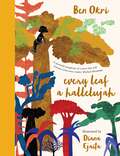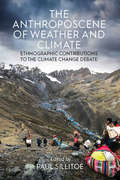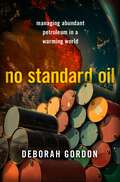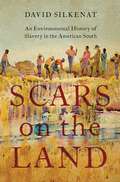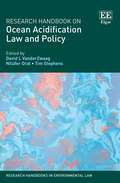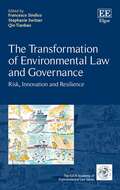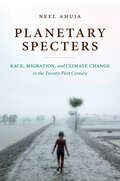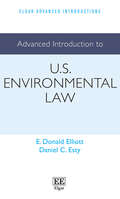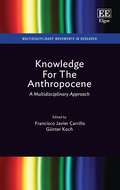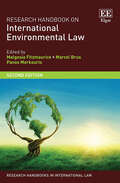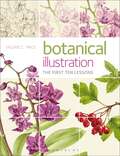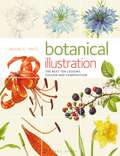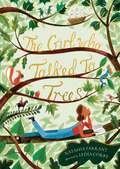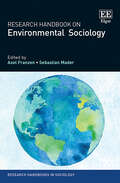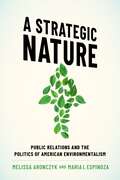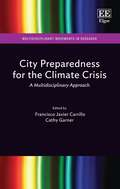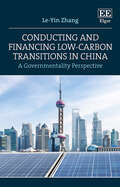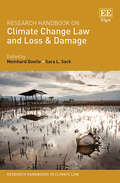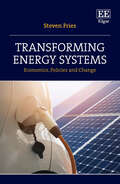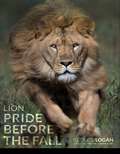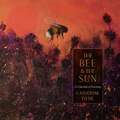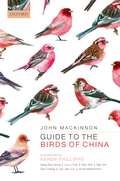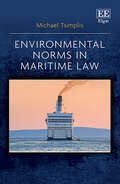- Table View
- List View
Every Leaf a Hallelujah
by Ben OkriA Guardian Children's Book of the Year An environmental fairytale made for our times, written to be read by adults and children, from the Booker Prize-winning author of The Famished Road. In the forest near Mangoshi's village in Africa there grows a very special flower. Mangoshi knows that only this flower can save her mother's life. It can save her village too. All she has to do is find it.Ben Okri and Diana Ejaita have created a magical world of beauty and colour, an enchanting array of extraordinary trees, each with its own personality and voice. The chief among them, the great baobab, invites us into his branches to travel the world and see for ourselves the perils of not listening to nature. All around us, forests are vanishing, and no one is listening.'It was a sheer joy to be able to read this. It is mysterious and magical and true. Children and those who read it to them will love it and long remember it. The illustrations are woven wonderfully around the words; the trees are with you, telling it, writing it. Once read we will know never to take trees or leaves for granted again. A powerful symphony of a story that will resonate for every reader. We hear the wind in the trees on every page. We only have to listen' MICHAEL MORPURGO
The Anthroposcene of Weather and Climate: Ethnographic Contributions to the Climate Change Debate
by Paul SillitoeWhile it is widely acknowledged that climate change is among the greatest global challenges of our times, it has local implications too. This volume forefronts these local issues, giving anthropology a voice in this great debate, which is otherwise dominated by natural scientists and policy makers. It shows what an ethnographic focus can offer in furthering our understanding of the lived realities of climate debates. Contributors from communities around the world discuss local knowledge of, and responses to, environmental changes that need to feature in scientifically framed policies regarding mitigation and adaptation measures if they are to be effective.
No Standard Oil: Managing Abundant Petroleum in a Warming World (Carnegie Endowment for International Peace)
by Deborah GordonIn No Standard Oil, environmental policy expert Deborah Gordon examines the widely varying climate impacts of global oils and gases, and proposes solutions to cut greenhouse gas emissions in this sector while making sustainable progress in transitioning to a carbon-free energy future. The next decade will be decisive in the fight against climate change. It will be impossible to hold the planet to a 1.5o C temperature rise without controlling methane and CO2 emissions from the oil and gas sector. Contrary to popular belief, the world will not run out of these resources anytime soon. Consumers will continue to demand these abundant resources to fuel their cars, heat their homes, and produce everyday goods like shampoo, pajamas, and paint. But it is becoming more environmentally damaging to supply energy using technologies like fracking oil and liquefying gas. Policymakers, financial investors, environmental advocates, and citizens need to understand what oil and gas are doing to our climate to inform decision-making. In No Standard Oil, Deborah Gordon shows that no two oils or gases are environmentally alike. Each has a distinct, quantifiable climate impact. While all oils and gases pollute, some are much worse for the climate than others. In clear, accessible language, Gordon explains the results of the Oil Climate Index Plus Gas (OCI+), an innovative, open source model that estimates global oil and gas emissions. Gordon identifies the oils and gases from every region of the globe-along with the specific production, processing, and refining activities-that are the most harmful to the planet, and proposes innovative solutions to reduce their climate footprints. Global climate stabilization cannot afford to wait for oil and gas to run out. No Standard Oil shows how we can take immediate, practical steps to cut greenhouse gas emissions in the crucial oil and gas sector while making sustainable progress in transitioning to a carbon-free energy future.
Scars on the Land: An Environmental History of Slavery in the American South
by David SilkenatThey worked Virginia's tobacco fields, South Carolina's rice marshes, and the Black Belt's cotton plantations. Wherever they lived, enslaved people found their lives indelibly shaped by the Southern environment. By day, they plucked worms and insects from the crops, trod barefoot in the mud as they hoed rice fields, and endured the sun and humidity as they planted and harvested the fields. By night, they clandestinely took to the woods and swamps to trap opossums and turtles, to visit relatives living on adjacent plantations, and at times to escape slave patrols and escape to freedom. Scars on the Land is the first comprehensive history of American slavery to examine how the environment fundamentally formed enslaved people's lives and how slavery remade the Southern landscape. Over two centuries, from the establishment of slavery in the Chesapeake to the Civil War, one simple calculation had profound consequences: rather than measuring productivity based on outputs per acre, Southern planters sought to maximize how much labor they could extract from their enslaved workforce. They saw the landscape as disposable, relocating to more fertile prospects once they had leached the soils and cut down the forests. On the leading edge of the frontier, slavery laid waste to fragile ecosystems, draining swamps, clearing forests to plant crops and fuel steamships, and introducing devastating invasive species. On its trailing edge, slavery left eroded hillsides, rivers clogged with sterile soil, and the extinction of native species. While environmental destruction fueled slavery's expansion, no environment could long survive intensive slave labor. The scars manifested themselves in different ways, but the land too fell victim to the slave owner's lash. Although typically treated separately, slavery and the environment naturally intersect in complex and powerful ways, leaving lasting effects from the period of emancipation through modern-day reckonings with racial justice.
Research Handbook on Ocean Acidification Law and Policy (Research Handbooks in Environmental Law series)
This important Research Handbook provides a guide to navigating the tangled array of laws and policies available to counter the multiple threats of ocean acidification. It investigates the limitations and opportunities for addressing ocean acidification under global governance frameworks, including multilateral environmental agreements, law of the sea and human rights instruments. The book also describes regional and national approaches and challenges in responding to ocean acidification. The special vulnerabilities of the Arctic, Antarctic and South Pacific are highlighted. Limited responses by regional sea programmes and regional fisheries management organizations are summarized. Case studies are provided from Australia, Brazil, China and the United States. This discerning Research Handbook will be a welcome read for policy makers and students with an interest in the laws and policies of marine governance and climate change. This will also be an ideal read for those who are interested in the pressing environmental issues facing the world community.
The Transformation of Environmental Law and Governance: Risk, Innovation and Resilience (The IUCN Academy of Environmental Law series)
This cutting-edge book considers the functional inseparability of risk and innovation within the context of environmental law and governance. Analysing both ‘hard’ and ‘soft’ innovation, the book argues that approaches to socio-ecological risk require innovation in order for society and the environment to become more resilient.In addition to risk and innovation, this book also highlights the need for resilience thinking in environmental law and governance, questioning whether these three factors are mutually supportive. Featuring wide geographical coverage of environmental law issues in both developing and developed nations, contributions posit that environmental law and governance is in a constant state of transformation. Throughout the book, discrete topics such as oceans, climate change and biodiversity are considered alongside intersecting themes such as human rights and litigation.Featuring up to date analysis of cutting edge topics by leading scholars in the field, The Transformation of Environmental Law and Governance will be a key resource for academics and students in the fields of environmental law, governance and regulation and environmental politics and policy. The valuable insights offered will also be beneficial for practitioners and lawmakers involved in the development of environmental law.
Planetary Specters: Race, Migration, and Climate Change in the Twenty-First Century
by Neel AhujaNeel Ahuja tracks the figure of the climate refugee in public media and policy over the past decade, arguing that journalists, security experts, politicians, and nongovernmental organizations have often oversimplified climate change and obfuscated the processes that drive mass migration. To understand the systemic reasons for displacement, Ahuja argues, it is necessary to reframe climate disaster as interlinked with the history of capitalism and the global politics of race, wherein racist presumptions about agrarian underdevelopment and Indigenous knowledge mask how financial, development, migration, and climate adaptation policies reproduce growing inequalities. Drawing on the work of Cedric Robinson and theories of racial capitalism, Ahuja considers how the oil industry transformed the economic and geopolitical processes that lead to displacement. From South Asia to the Persian Gulf, Europe, and North America, Ahuja studies how Asian trade, finance, and labor connections have changed the nature of race, borders, warfare, and capitalism since the 1970s. Ultimately, Ahuja argues that only by reckoning with how climate change emerges out of longer histories of race, colonialism, and capitalism can we begin to build a sustainable and just future for those most affected by environmental change.
Advanced Introduction to U.S. Environmental Law (Elgar Advanced Introductions series)
by Daniel C. Esty E. D. ElliottElgar Advanced Introductions are stimulating and thoughtful introductions to major fields in the social sciences, business and law, expertly written by the world’s leading scholars. Designed to be accessible yet rigorous, they offer concise and lucid surveys of the substantive and policy issues associated with discrete subject areas. Providing a comprehensive overview of the current and developing state of environmental governance in the United States, this Advanced Introduction lays out the foundations of U.S. environmental law. E. Donald Elliott and Daniel C. Esty explore how federal environmental law is made and how it interacts with state law, highlighting the important role that administrative agencies play in the creation, implementation, and enforcement of U.S. environmental law. Key features include: an examination of the key statutes, case law, and controversies involved in the regulation of natural resourcesa survey of the broad range of regulations and legal principles that govern the protection of the environment in the United Statesanalysis of relevant statutes for specific issues including air and water pollution, climate change, endangered species, wilderness preservation, hazardous waste, and pesticides. This Advanced Introduction will be a valuable resource for scholars and students of environmental law. It will also be beneficial for environmental lawyers, business executives, NGO leaders, policymakers, and think tank analysts who work on environmental issues.
Knowledge For The Anthropocene: A Multidisciplinary Approach (Multidisciplinary Movements in Research)
With human-induced environmental impacts disrupting human life in deeper ways and at a wider scale than anything previously experienced, this multidisciplinary book looks at the ways that current knowledge bases seem inadequate to help us deal with such realities. It offers a critical appraisal of the current knowledge infrastructure, including science, technology, innovation, education and informal knowledge systems. Contributions from a wide spectrum of social scientists, philosophers, activists and decision-makers tackle the importance of knowledge for the Anthropocene using a mosaic of data, theories, cases, models, methods and experiences. Chapters highlight what relevant knowledge will become critical to dealing with deteriorating environmental conditions, as well as how science, technology, education and innovation can be radically transformed to deal with these challenges. The book further explores the behavioural, economic, social and cultural aspects of the Anthropocene, and how knowledge impacts both these and our possible futures. This will be a critical read for human geography and environmental science scholars, as well as social science scholars more broadly, particularly with its in-depth glossary and digital resource list. It will also aid practitioners in the planning, design, management and evaluation of knowledge systems by providing deeper understandings of the potential circumstances of knowledge in the Anthropocene.
Research Handbook on International Environmental Law (Research Handbooks in International Law series)
This thoroughly updated and revised second edition combines practical and theoretical analyses to cover a wide array of cutting edge issues in international environmental law (IEL). The Research Handbook provides a comprehensive view of the complexity of IEL, both as a field in its own right, and as part of the wider system of international law.Expert contributors examine the key theories and concepts of IEL governance and provide an in-depth analysis of IEL principles, supplemented in this new edition by a consideration of the significant actors involved in international environmental law-making and governance. Chapters go on to discuss practical issues, such as dispute settlement and compliance, and analyse selected environmental protection regimes, as well as including a brand new section covering IEL litigation in relation to human rights and climate change.Providing a thorough examination of the major topics in the field, this Handbook will be an indispensable resource for scholars and students of international environmental law. Practitioners and policymakers will also find it useful for its coverage of developments in environmental litigation and the actors involved.
Botanical Illustration: The First Ten Lessons
by Valerie PriceThis practical introduction to botanical illustration is formed of ten graded lessons, where each teaches you new skills to build upon the last. From mushrooms to orchids to hawthorn berries and leaves; once you've completed these lessons in drawing and painting botanical subjects, you will have all the techniques you need in order to tackle far more complex arrangements. An experienced teacher of botanical illustration, Valerie Price shows even the uninitiated illustrator how to produce accurate and beautiful results, with her step-by-step instructions on how to tackle each individual project.With advice on topics including accurate drawing, measuring and recording your subject, right the way through to preparing a well-composed botanical plate, this book covers everything you need to know to get ahead in botanical illustration.
Botanical Illustration The Next Ten Lessons: Colour and Composition
by Valerie PriceBuilding on Valerie Price's previous and highly successful book, Botanical Illustration: The First Ten Lessons, this next volume provides a practical introduction to colour and composition in botanical illustrations. Formed of ten graded lessons, each chapter teaches a new skill that builds upon the last, with subjects that range from red tulips and pink roses to blackberries and green foliage. Full of handy information, and with easy-to-follow exercises, the book includes step-by-step instructions that show artists of all levels how to produce beautiful colour in their compositions.This practical guide includes essential information on different watercolour techniques, how to arrange informative compositions and mix your own colours to achieve lifelike results.
The Girl Who Talked to Trees
by Natasha FarrantMagical interlinked stories about what one girl learns from talking to trees throughout Time and from around the world in a sumptuous gift book presentation. From the team who brought you Eight Princesses and a Magic Mirror, Costa Book Award winning Natasha Farrant and Lydia Corry. Olive's best friend is a four-hundred-year-old oak tree, and it is in danger. As she tumbles into its magic world, she makes it a promise. From deep roots to high branches, a Persian garden to an underwater forest, from tulip trees to wild apple to vengeful box, she listens to the trees telling stories for all time. And she keeps her promise.With a conservation message and facts about tree science alongside the magic and wonder of seven beautifully imagined original stories, this full-colour gift book enchants and reminds us of the importance of trees in our lives.'Terrific and inspirational' Irish Times
Research Handbook on Environmental Sociology (Research Handbooks in Sociology series)
This Research Handbook presents the state of the art of empirical sociological research on the causes of, and solutions to, pressing environmental problems. It provides cutting-edge insights into some of the most urgent challenges facing humanity, including anthropogenic climate change and environmental pollution. The contributors argue that profound collective efforts to protect the environment are vital for sustainable development and offer practical solutions to specific contemporary issues.Wide ranging and insightful, this Research Handbook encompasses the causes and consequences of environmental deterioration, the measurement, development and precedents of environmental concern, the determinants of pro-environmental behavior, and the acceptance of environmental policies. Key topics include the development of global CO2 emissions, prices, income and energy demand, climate change knowledge, meta-knowledge and beliefs, the collective risk social dilemma and support for city road tolls. Scholars and students in the environmental social sciences will find this innovative Research Handbook invaluable. Critical case studies also provide important insights and recommendations for environmental decision makers.
Watercolour Secrets
by Jill LemanThis beautiful book showcases the work of the members of the prestigious Royal Watercolour Society, including Ken Howard, Sonia Lawson and many other fine and well-known contemporary watercolour painters. Each artist discusses their inspiration and gives their best practical advice for working in this medium, offering a fascinating insight into the methods and techniques of the professional artists. Have you ever wondered how an artist starts a piece, what keeps them working at it, how they make marks and mix colour or when they know a painting is finished? This intimate exploration of the daily creative striving of the artist and their patient technical procedures will fascinate professional and aspiring artists, collectors and anyone with a general interest in painting.
A Strategic Nature: Public Relations and the Politics of American Environmentalism
by Melissa Aronczyk Maria I. EspinozaA look at how public relations has dominated public understanding of the natural environment for over one hundred years. In A Strategic Nature, Melissa Aronczyk and Maria I. Espinoza examine public relations as a social and political force that shapes both our understanding of the environmental crises we now face and our responses to them. Drawing on in-depth interviews, ethnography, and archival research, Aronczyk and Espinoza document the evolution of PR techniques to control public perception of the environment since the beginning of the twentieth century. More than spin or misinformation, PR affects how institutions and individuals conceptualize environmental problems -- from conservation to coal mining to carbon credits. Revealing the linkages of professional strategists, information politics, and environmental standards, A Strategic Nature shows how public relations restricts alternative paths to a sustainable climate future.
City Preparedness for the Climate Crisis: A Multidisciplinary Approach (Multidisciplinary Movements in Research)
Exploring the ways that contemporary urban life takes the Holocene for granted, this multidisciplinary book warns that anthropogenic environmental impacts are on course to challenge the viability of most human settlements. It highlights how, despite increased warnings, most cities appear to be in denial of the potential impending catastrophes and remain ill-prepared to handle major disruptions. Chapters offer a critical appraisal of the end of an urban epoch: the Holocene city. Moving from more general aspects of urban vulnerability in the face of the Anthropocene, the book then looks at more specific issues and cases illustrating alternative adaptation pathways. It further analyses existing approaches, movements and networks for urban preparedness for the climate crisis, offering visualisations of the ways these can be improved, conceiving alternative futures and reinventing the city. A timely resource for this emerging topic, the book will be beneficial to urban studies, environmental science and development studies scholars. Practitioners in urban planning, design, management and evaluation will also find the critical case studies in the book particularly helpful.
Conducting and Financing Low-carbon Transitions in China: A Governmentality Perspective
Utilizing a governmentality lens, this timely book offers an explanation for China’s decarbonization performance in the early 21st century. Le-Yin Zhang investigates one of the most ambitious governing projects in history, analyzing the political rationalities of Chinese leaders for decarbonization and the governing techniques and technologies at multiple levels of governance. Demonstrating the potential of combining the use of juridical, administrative and governmental powers, Zhang holistically considers the success of the state in instigating low-carbon transitions in China and mitigating climate disaster. The book provides an in-depth exploration of the art of greening the Chinese financial system and how this links to a wider formulation of carbon governmentality, highlighting the rise of the carbon governmental state through a range of governmental technologies. Engaging with a wide range of primary data from both national and local levels, the author uncovers profound lessons in low-carbon transitions for other states in the making of a carbon neutral world. This cutting-edge book offers key insights for scholars and researchers of environmental governance and its importance in mitigating climate change, particularly those with a key focus on Chinese climate policy. It will also benefit government officials, researchers and consultants investigating potential avenues for low-carbon transition and climate action.
Research Handbook on Climate Change Law and Loss & Damage (Research Handbooks in Climate Law series)
This timely Research Handbook offers an insightful review of how legal systems – whether domestic, international or transnational – can and should adjust to fairly and effectively support loss and damage (L&D) claims in climate change law. International contributors guide readers through a detailed assessment of the history and current state of L&D provisions under the UN climate regime and consider the opportunities to fund L&D claims both within and outside the UN climate system. Split into four parts, the Research Handbook investigates the current legal frameworks for L&D across both public international law and domestic law. Chapters explore foundational issues including equity and justice and give a critical assessment of the current state and potential future evolution of international legal systems. The contributing authors also discuss the challenges faced by different legal systems in dealing effectively and fairly with L&D.Providing a comprehensive overview of this important topic, this Research Handbook will be an excellent resource for climate lawyers and policymakers. It will also be an invaluable read for academics and students researching environmental and climate issues.
Transforming Energy Systems: Economics, Policies and Change
by Steven FriesRecognizing the urgent need to transform energy systems to low-carbon alternatives, this timely book offers evidenced and credible ways to accelerate actions towards meeting the Paris Agreement goals and achieving net zero emissions. Steven Fries analyses through the lens of government, business and household actions—their policies and investments—the systemic changes needed to eliminate net carbon dioxide emissions from energy.Fries explores how advancing low-carbon alternatives could maintain current economic activities while halting climate impacts. But his analysis of accumulating evidence on transforming energy shows how multiple market imperfections hold back alternatives. To overcome these barriers, the book develops heterodox energy reform strategies and ways to coordinate actions across countries, recognizing differences in their specializations and renewable resources. Going beyond orthodox economics, it sets out the role for supporting deployment of low-carbon alternatives in initial markets, calibrating emissions pricing to net zero emission goals, and adapting institutions and infrastructures to low-carbon alternatives. It also signposts policy sequencing and differentiation across sectors and countries.Providing comprehensive energy policy assessments and sound reform strategies, this book will be essential reading for government policymakers and business investors. Its rigorous approach to systemic change also makes it a valuable reference for energy economics and environmental economics scholars.
Lion: Pride Before The Fall
by George LoganAcclaimed wildlife photographer George Logan’s book of stunning wildlife photography produced to support and raise awareness of Africa’s dwindling’s lion population is now available as an eBook.The book, Lion: Pride Before The Fall, contains a collection of the London-based photographer’s beautiful and thought-provoking images of lions in the wild in Africa.The photographs, which celebrate the lifecycle of the lion in all of its raw beauty, serve as a stark reminder of what we stand to lose – and with fewer than 20,000 African lions left, time is running out to safeguard their future.The foreword to the book was written by Born Free founder and actress, Virginia McKenna OBE. She says: “No one, in my view, more strikingly has caught the multiple dimensions of lions’ behaviour and depth of character than George Logan. He has an unfailing sensitivity and admiration for the individual animal. This, for me, shines through each page of the book and is deeply moving in so many ways.”George Logan says: "This work, the culmination of over 10 years following and photographing Africa’s lion prides, brings their dramatic narrative to life. It’s difficult to articulate the depths of what we stand to lose, but I hope that through this book, the lions will help tell that story. All profits from this book will raise vital funds to support, protect and help re-establish the Last Lions of Meru, a major conservation initiative in Kenya, which works to protect and increase the lion population there, which currently stands at just 60-80 lions.”“Uniquely for a wildlife book, we’ve collaborated with some of the best creative minds at London's top agencies to produce powerful imagery which confronts and highlights the dangers that the last remaining lions still face, such as habitat-loss, canned hunting, trophy hunting, human-wildlife conflict and the real possibility of extinction.
Feminist Solutions for Ending War
‘War is a man’s game,’ or so goes the saying. Whether this is true or not, patriarchal capitalism is certainly one of the driving forces behind war in the modern era. So can we end war with feminism? This book argues that this is possible, and is in fact already happening. Each chapter provides a solution to war using innovative examples of how feminist and queer theory and practice inform pacifist treaties, movements and methods, from the international to the domestic spheres. The contributors propose a range of solutions that include arms abolition, centring Indigenous knowledge, economic restructuring, and transforming how we ‘count’ civilian deaths. Ending war requires challenging complex structures, but the solutions found in this edition have risen to this challenge. By thinking beyond the violence of the capitalist patriarchy, this book makes the powerful case that the possibility of life without war is real.
The Bee and the Sun: A Calendar of Paintings
by Catherine HydeCatherine Hyde follows the journey of the bee and the sun in a calendar of glorious full colour paintings that celebrate the sensory delights of herbs, seasoned with bee and plant lore.From the rising and setting of the Pleiades, from sunrise to sunset, the bee and the sun work in harmony, a miracle of nature, growth and new life. Beneath the shifting constellations, equinoxes and solstice markers, as the bee progresses from plant to flower, acclaimed artist Catherine Hyde pays tribute to the magic and mystery of nature.Snippets of ancient bee beliefs and plant folklore are complemented by paintings of wild thyme, saffron, meadow sweet, basil, mallow, lavender and many more delights. A book to treasure, and an ode to the wonder of nature.'This is a treasure... Such a celebration of the wheel of the year' JACKIE MORRIS, CILIP Kate Greenaway winner of The Lost Words, on The Hare and the Moon
Guide to the Birds of China
by John MacKinnonChina covers about 7% of the earth's land surface and encompasses a hugely diverse range of habitats. As a result, it boasts a rich and diverse avifauna, including some of the most spectacular and fascinating birds to be found anywhere in the world. Building on the enormous popularity and reputation of the original A Field Guide to the Birds of China (2000), John MacKinnon's fully updated and refreshed work remains a truly comprehensive, taxonomically modern, fully illustrated, and authoritative field guide. 1484 bird species are richly illustrated in 164 annotated colour plates, which are closely integrated with up-to-date colour distribution maps, QR codes providing easy access to birdcalls, IUCN Red List status indicators and new, concise descriptions. These descriptions feature key observations as well as conveying crucial changes to species distributions resulting from climate change and landscape transformation. Guide to the Birds of China will appeal to an international and growing audience of professional and amateur ornithologists and birding enthusiasts, academic researchers and students, wildlife photographers, and conservationists.
Environmental Norms in Maritime Law
by Michael TsimplisThis timely book examines the reform of maritime law under the influence of environmental principles and the effects of these changes in the legal relationships between maritime stakeholders. Providing an integrated assessment of the use of environmental principles in the governance of shipping and maritime law, it argues that normative barriers supported by short term financial interests, the balance of power between states and the technocratic character of the IMO are delaying necessary changes to support sustainable development and thus endanger the marine environment.Offering a complete review of the environmental impacts of shipping, Michael Tsimplis analyses the compatibility of maritime conventions with environmental norms, developing a methodology using publicly available documents of the International Maritime Organisation. He discusses what would be required in terms of governance for sustainability in the maritime sector, proposing a number of ways of removing barriers within a strategy of zero discharges, zero emissions, and zero impact.Scholars and students of maritime and environmental law will find this book’s analysis of how environmental principles affect both public and private law aspects of the shipping sector illuminating. It will also be of interest to policy makers and regulators in the maritime and environment sectors looking for an overview of the issues involved in improving environmental performance in shipping.– Regina Asariotis, United
